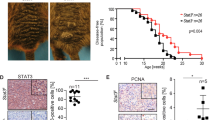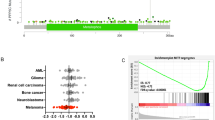Abstract
The promyelocytic leukemia zinc finger (PLZF) protein has been described as a transcriptional repressor of homeobox (HOX)-containing genes during embryogenesis. As we previously demonstrated a functional link between overexpression of HOXB7 and melanoma progression, we investigated the lack of PLZF as the possible cause of HOXB7 constitutive activation in these neoplastic cells. Accordingly, we found PLZF expression in melanocytes, but not in melanoma cells, a pattern inversely related to that of HOXB7. PLZF retroviral gene transduction was then performed in a panel of melanoma cell lines, and tumorigenicity was compared with that of empty vector-transduced control cell lines. Evaluation of in vitro migration, invasion and adhesion indicated that PLZF gene transduction induced a less malignant phenotype, as confirmed through in vivo studies performed in athymic nude mice. This reduced tumorigenicity was not coupled with HOXB7 repression. In order to find more about the molecular targets of PLZF, the gene expression profiles of PLZF- and empty vector-transduced A375 melanoma cells were analysed by Atlas Cancer macroarray. Among several genes modulated by PLZF enforced expression, of particular interest were integrin αvβ3, osteonectin/SPARC and matrix metalloprotease-9 that were downmodulated, and the tyrosinase-related protein-1 that was upregulated in all the analysed samples. This profile confirms the reduced tumorigenic phenotype with reversion to a more differentiated, melanocyte like, pattern, thus suggesting a suppressor role for PLZF in solid tumors. Moreover, these results indicate that PLZF and HOXB7 are functionally independent and that their coupled deregulation may account for most of the alterations described in melanomas.
This is a preview of subscription content, access via your institution
Access options
Subscribe to this journal
Receive 50 print issues and online access
$259.00 per year
only $5.18 per issue
Buy this article
- Purchase on Springer Link
- Instant access to full article PDF
Prices may be subject to local taxes which are calculated during checkout







Similar content being viewed by others
Abbreviations
- HOX:
-
homeobox
- PLZF:
-
promyelocytic leukemia zinc finger
- Abd-B:
-
Abdominal-B
- MMP:
-
matrix metalloprotease
- TRP-1:
-
tyrosinase related protein-1
- APL:
-
acute promyelocytic leukemia
- RAR:
-
retinoic acid receptor
- B-CLL:
-
B-chronic lymphocytic leukemia
- RGP:
-
radial growth phase
- VGP:
-
vertical growth phase
References
Abate-Shen C . (2002). Nat. Rev. Cancer, 2, 777–785.
Albini A, Iwamoto Y, Kleinman HK, Martin GR, Aaronson SA, Kozlowski JM and McEwan RN . (1987). Cancer Res., 47, 3239–3245.
Alvino E, Marra G, Pagani E, Falcinelli S, Pepponi R, Perrera C, Haider R, Castiglia D, Ferranti G, Bonmassar E, Jiricny J, Zambruno G and D'Atri S . (2002). J. Invest. Dermatol., 118, 79–86.
Barna M, Hawe N, Niswander L and Pandolfi PP . (2000). Nat. Genet., 25, 166–172.
Barna M, Merghoub T, Costoya JA, Ruggero D, Branford M, Bergia A, Samori B and Pandolfi PP . (2002). Dev. Cell, 3, 499–510.
Boukerche H, Berthier-Vergnes O, Tabone E, Bailly M, Dore JF and McGregor JL . (1995). Br. J. Cancer, 72, 108–116.
Carè A, Felicetti F, Meccia E, Bottero L, Parenza M, Stoppacciaro A, Peschle C and Colombo MP . (2001). Cancer Res., 61, 6532–6539.
Carè A, Silvani A, Meccia E, Mattia G, Peschle C and Colombo MP . (1998). Oncogene, 16, 3285–3289.
Carè A, Silvani A, Meccia E, Mattia G, Stoppacciaro A, Parmiani G, Peschle C and Colombo MP . (1996). Mol. Cell. Biol., 16, 4842–4851.
Chen Z, Brand NJ, Chen A, Chen SJ, Tong JH, Wang ZY, Waxman S and Zelent A . (1993). EMBO J., 12, 1161–1167.
Cohen T, Muller RM, Tomita Y and Shibahara S . (1990). Nucleic Acids Res., 18, 2807–2808.
Cook M, Gould A, Brand N, Davies J, Strutt P, Shaknovich R, Licht J, Waxman S, Chen Z, Gluecksohn-Waelsch S, Krumlauf R and Zelent A . (1995). Proc. Natl. Acad. Sci. USA, 92, 2249–2253.
Dhordain P, Albagli O, Honore N, Guidez F, Lantoine D, Schmid M, De The H, Zelent A and Koken MHM . (2000). Oncogene, 19, 6240–6250.
Dong S, Zhu J, Reid A, Strutt P, Guidez F, Zhong HJ, Wang ZY, Licht J, Waxman S, Chomienne C, Chen Z, Zelent A and Chen S-J . (1996). Proc. Natl. Acad. Sci. USA, 93, 3624–3629.
Dubrulle J and Pourquie O . (2002). Curr. Opin. Genet. Dev., 12, 519–523.
Fang D, Tsuji Y and Setaluri V . (2002). Nucleic Acids Res., 30, 3096–3106.
He LZ, Guidez F, Tribioli C, Peruzzi D, Ruthardt M, Zelent A and Pandolfi PP . (1998). Nat. Genet., 18, 126–135.
Hoatlin ME, Zhi Y, Ball H, Silvey K, Melnick A, Stone S, Arai S, Hawe N, Owen G, Zelent A and Licht JD. (1999). Blood, 94, 3737–3747.
Hofmann UB, Westphal JR, Waas ET, Becker JC, Ruiter DJ and van Muijen GN . (2000). J. Invest. Dermatol., 115, 625–632.
Krug U, Ganser A and Koeffler HP . (2002). Oncogene, 21, 3475–3495.
Labbaye C, Quaranta MT, Pagliuca A, Militi S, Licht JD, Testa U and Peschle C . (2002). Oncogene, 21, 6669–6679.
Lacal PM, Failla CM, Pagani E, Odorisio T, Schietroma C, Falcinelli S, Zambruno G and D'Atri S . (2000). J. Invest. Dermatol., 115, 1000–1007.
Ledda MF, Adris S, Bravo AI, Kairiyama C, Bover L, Chernajovsky Y, Mordoh J and Podhajcer OL . (1997). Nat. Med., 3, 171–176.
Li JY, English MA, Ball HJ, Yeyati PL, Waxman S and Licht JD . (1997). J. Biol. Chem., 272, 22447–22455.
Licht JD, Chomienne C, Goy A, Chen A, Scott AA, Head DR, Michaux JL, Wu Y, DeBlasio A, Miller Jr WH, Zelenetz AD, Willman CL, Chen Z, Chen S-J, Zelent A, Macintyre E, Veil A, Corets J, Kantarjian H and Waxman S . (1995). Blood, 85, 1083–1094.
Livak KL and Schmittgen TD . (2001). Methods, 25, 402–408.
McPherson LA, Baichwal VR and Weigel RJ . (1997). Proc. Natl. Acad. Sci. USA, 94, 4342–4347.
Meccia E, Bottero L, Felicetti F, Peschle C, Colombo MP and Carè A . (2003). Biochem. Biophys. Acta, 1626, 1–9.
Niu J, Dorahy DJ, Gu X, Scott RJ, Draganic B, Ahmed N and Agrez MV . (2002). Int. J. Cancer, 99, 529–537.
Nomura N, Miyajima N, Sazuka T, Tanaka A, Kawarabayasi Y, Sato S, Nagase T, Seki N, Ishikawa K and Tabata S . (1994). DNA Res., 1, 27–35.
Ohashi K, Mizuno K, Kuma K, Miyata T and Nakamura T . (1994). Oncogene, 9, 699–705.
Parrado A, Noguera ME, Delmer A, McKenna S, Davies J, Le Gall I, Bentley P, Whittaker JA, Sigaux F, Chomienne C and Padua RA . (2000). Hematol. J., 1, 15–27.
Pati D, Zhang N and Plon SE . (2002). Mol. Cell. Biol., 22, 8267–8277.
Reid A, Gould A, Brand N, Cook M, Strutt P, Li J, Licht J, Waxman S, Krumlauf R and Zelent A . (1995). Blood, 86, 4544–4552.
Satyamoorthy K and Herlyn M . (2002). Cancer Biol. Ther., 1, 14–17.
Seftor RE . (1998). Am. J. Pathol., 153, 1347–1351.
Sturm RA, Satyamoorthy K, Meier F, Gardiner BB, Smit DJ, Vaidya B and Herlyn M . (2002). Cancer Res., 62, 226–232.
Van Belle PA, Elenitsas R, Satyamoorthy K, Wolfe JT, Guerry 4th D, Schuchter L, Van Belle TJ, Albelda S, Tahin P, Herlyn M and Elder DE . (1999). Hum. Pathol., 30, 562–567.
van den Oord JJ, Paemen L, Opdenakker G and de Wolf-Peeters C . (1997). Am. J. Pathol., 151, 665–670.
Yeyati PL, Shaknovich R, Boterashvili S, Li J, Ball HJ, Waxman S, Nason-Burchenal K, Dmitrovsky E, Zelent A and Licht JD . (1999). Oncogene, 18, 925–934.
Acknowledgements
PG Pelicci is acknowledged for providing us with PLZF polyclonal antibody and S D'Atri for some melanoma samples. We thank G Loreto for the preparation of the figures. This work was supported by The Italy-USA Special Project on Therapy of Tumors and by The Italian Ministry of Health. FF was supported by a fellowship from the Italian Foundation for Cancer Research (FIRC).
Author information
Authors and Affiliations
Corresponding author
Rights and permissions
About this article
Cite this article
Felicetti, F., Bottero, L., Felli, N. et al. Role of PLZF in melanoma progression. Oncogene 23, 4567–4576 (2004). https://doi.org/10.1038/sj.onc.1207597
Received:
Revised:
Accepted:
Published:
Issue Date:
DOI: https://doi.org/10.1038/sj.onc.1207597
Keywords
This article is cited by
-
PLZF inhibits proliferation and metastasis of gallbladder cancer by regulating IFIT2
Cell Death & Disease (2018)
-
AP2α controls the dynamic balance between miR-126&126* and miR-221&222 during melanoma progression
Oncogene (2016)
-
Implication of intracellular localization of transcriptional repressor PLZF in thyroid neoplasms
BMC Endocrine Disorders (2014)
-
Expression of H1.5 and PLZF in granulosa cell tumors and normal ovarian tissues: a short report
Cellular Oncology (2014)
-
HOXB1 restored expression promotes apoptosis and differentiation in the HL60 leukemic cell line
Cancer Cell International (2013)



